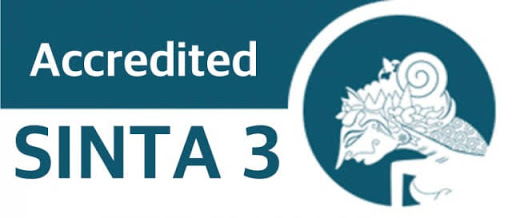The Effect of Personality Traits And Congruity on Customer Satisfaction and Brand Loyalty on Janji Jiwa Coffee in Surabaya
 Abstract Views:
1218 times
Abstract Views:
1218 times
 PDF Downloads:
692 times
PDF Downloads:
692 times
Abstract
The purpose of this research aims to prove the effect of personality traits and congruity to customer satisfaction and brand loyalty on Janji Jiwa in Surabaya.
The type of research used is basic business research with causal objectives and quantitative research approaches. This research uses a purposive sampling approach with the sample is respondents aged 18 years and above and have consumed Samyang instant noodles. Respondents used in this study were 180 people. The analysis in this study is SEM (Structural Equation Modeling) and then processed using SPSS software version 20 for windows and also AMOS version 21.0 for windows used for testing the Measurement Model (Outer Model) and Structural Model (Inner Model).
Keywords: personality traits, congruity, customer satisfaction, brand loyalty
Downloads
References
Aaker, J. F. (2004). when good brand do bad. Journal of cutomer research, 31(1), 1-16.
Anderson, J., & Gerbing, D. (1988). Structural equation modelling in practice. A review and recommended two-step approach. Psychological Bulletin, 103(3), 411-423.
Ayodya, Wulan. (2007). Kursus singkat usaha rumah makan laris manis. Jakarta: PT Elex Media Komputindo
Back, K. J. (2003). A brand loyalty model involving cognitive, affective, and conative brand loyalty and customer satisfaction. Journal of Hospitaly & Tourism Research , 27(4), 419-435.
Beerli, A. M. (2007). Self congruity and destination choice. Annals of Tourism Research, 34(3), 571-587.
Bhote, k. R. (1996). Beyond customer satisfaction to customer loyalty. American management association, 56.
Durianto, D. S. (2004). Strategi menaklukan pasar melalui riset ekuitas dan perilaku konsumen. jakarta: gramedia.
Funder, D. (1997). the personality size. New York, NY: W.W Norton.
Govers, P., & Schoomans, J. (2005). Product personality and its influence on consumer preference. Journal of Consumer Marketing, Vol. 22 No.4: 189-197.
Gwinner, K. (1997). A model of image creation and image transfer in event sponsorship: The role of image transfer. International Marketing Review, 14(3), 145-158.
Hair, J. F., Black, W. C., Babin, B. J., Anderson, R. E., & Tatham, R. L. (2010). “Multivariate Data Analysis”. (7th Ed.). Upper Saddle River, NJ: Pearson.
Helgeson, J. &. (2004). A Conceptual and measurement comparison of self congruity and brand personality. International Jurnal of marketing research, 6(1), 205-233.
Kotler, P. (2000). Marketing management: Analysis, Planning, Implementation, and Control. New Jersey: Prentice Hall International, Inc.
Kressmann, F., Sirgy, M., Herrmann, A., Huber,F., Huber, S., & & Lee, D. (2006). Direct and indirect effect of self image congruence on brand loyalty. Journal of Bussiness Research, Vol.59 No.9: 955-964.
Lee, J. &. (2008). Hedonic/functional congruity between stores and private label brands. . The Journal of Marketing Theory and Practice, 16(3), 219-232.
Lee, J. &. (2009). Examining the effect of self-image congruence, relative to education and networking, on conference evaluation through its competing models and moderating effect. Journal of convention & Event Tourism, 10(4), 217-231.
Lounsbury, J. W. (2012). Key personality traits and career satisfaction of customer service workers . Mananging Service Quality: An International Journal, 22(5), 517-536.
Oliver, R. (1993). Cognitive, affective, and attributes bases of the satisfaction responses. Journal of consumer research, 20(3), 418-430.
Oliver, R. (1999). Whence consumer loyalty . Journal of marketing , 63(4) 33-34.
Schiffman, L. G. (2004). consumer behavior 8th edition. Pearson Prentice Hall.
Seimiene, E. (2012). Emotional connection of consumer personality traits with brand personality traits. Theoretical considerations. Economics and Management, 17(4), 1472-1478.
Sirgy, M. (2015). Self-image/product-image congruity and advertising strategy. In Proceeding of the 1982 Academy of Marketing Science (AMS) annual confrence (p. 129-133). Springer International Publishing.
Sirgy, M. J. (1997). Assesing the predictive validity of two methods of measuring self-image congruence. Journal of the academy of marketing science, 25(3), 229-241.
soekresno. (2002). Manajemen & beverage service hotel. Jakarta: PT. Gramedia Pustaka Utama.
Solomon, B., & & Jackson , J. (2014). Why do personality traits predict divorce? Multiple pathways through satisfaction. Journal of Personality and Social Psychology, 106(6), 978-996.
Sirgy, M. L. (2008). Effect of self-congruity with sponsorship on brand loyalty. Journal of bussines research, 61(10), 1091-1097.
Stanley, John dan Linda Stanley. (2015). Food Tourism A Practical Marketing Guide. UK: www.cabi.org
Wang , X., Yang, Z., & Liu, N. (2009). The impact of brand personality and congruity on purchase intention. Journal of Global Marketing, 22(3), 199-215.
Wilkie, W. L. (1994). Consumer behavior 3nd ed. John Wiley & Sons, Inc.
( https://www.bps.go.id,diunduh tanggal 10 september 2019)
(https://food.detik.com, diunduh tanggal 10 september 2019)
(www.instagram.com, diunduh tanggal 10 september 2019)
(https://travelingyuk.com, diunduh tanggal 10 september 2019)
(Kompas.com, diunduh tanggal 10 september 2019)
(https://www.yukmakan.com, diunduh tanggal 10 september 2019)

This work is licensed under a Creative Commons Attribution 4.0 International License.
Articles published in Journal of Entrepreneurship & Business are licensed under a Creative Commons Attribution 4.0 International (CC BY) license. You are free to copy, transform, or redistribute articles for any lawful purpose in any medium, provided you give appropriate credit to the original author(s) and the journal, link to the license, and indicate if changes were made.
Authors submitting to this journal agree to make their work freely available under the CC BY 4.0 license, ensuring broad dissemination and reuse. The full license details can be accessed at https://creativecommons.org/licenses/by/4.0/.
This ensures that they receive the maximum dissemination because there are no barriers to access. This license allows readers to disseminate and reuse the paper, but always requires them to grant the authors and the first publication full credit.
While JEB upholds ethical publishing standards, the responsibility for ensuring originality and compliance with copyright regulations lies with the authors. The journal is not liable for any legal claims related to the content of published articles.
For further inquiries, please contact the editorial team.

 DOI:
DOI:











